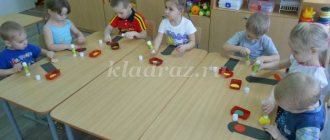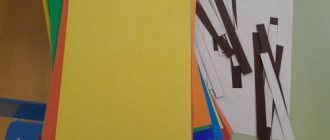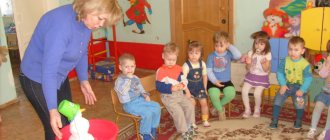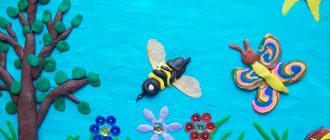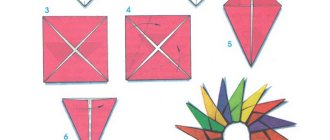Topic of the week: “Pets”
Lesson 17. Pig and kitten (Colored paper. Collective application from prepared parts of the object)
Program content. Teach children to compose a whole object from parts, carefully stick on appliqué parts; Bring the product to the desired image using felt-tip pens. Learn to accompany the words of the song with movements corresponding to the text. Learn to distinguish between wild and domestic animals. Continue to teach children to do teamwork.
Handout. For 5 children: album sheet; details cut out of orange paper: a circle (head), an oval (torso), 4 elongated ovals (legs) and 2 small triangles (ears); glue, glue brush, cloth, oilcloth lining, felt-tip pens.
Progress of the lesson
Sing an excerpt from O. Vatsietis’ song “What’s Who’s Song” with your kids, performing the appropriate movements:
The bird's song goes like this:
- Peak. Peak. Peak. (Palms with beak.)
The pig has this:
- Ryuh. Ryuh. Ryuh. (Make a “patch” from your thumb and index finger.)
The hedgehog's song goes like this:
- Plop. Plop. Plop. (Spread the fingers on your left hand (the spines) and clap it with your right palm.)
The kitty's song goes like this:
- Meow. Meow. (Stroke an imaginary cat with your hand.)
Ask the guys: “Who did we portray in this song? (A bird, a pig, a hedgehog, a kitten.) Which of these are considered pets?” (Piglet and kitten.)
Divide the children into teams of 5.
Give them landscape sheets and pieces cut out of orange paper: a circle (head), an oval (torso), 4 elongated ovals (legs) or 2 small triangles (ears).
The guys must decide for themselves who they will make - a pig or a kitten. Help them distribute the parts among themselves (one child gets the head, another gets two legs, the third gets ears, etc.). Then the children must make up the intended animal from the parts (it can stand on two legs or four, it can lie down), stick the parts on a landscape sheet; Use felt-tip pens to draw eyes, nose, mouth, tail.
Plasticine applique “Ornamental Christmas tree!” in the senior group
Goal: creating conditions for the development of creative abilities of preschool children and the development of fine motor skills.
Educational areas: artistic and aesthetic development, cognitive development, social and communicative development, speech development, physical development.
Objectives: 1. Artistic and aesthetic development. To cultivate emotional and aesthetic feelings in children, to develop artistic and creative abilities. Learn to convey the characteristic features of Christmas trees: crown shape, festive decoration. Learn to work with plasticine according to instructions. Develop the ability to correctly position a composition on a sheet of paper and carefully work with plasticine.
2. Cognitive development. To consolidate children's knowledge about winter changes in nature. Clarify the idea of the color scheme of the evergreen plant - the Christmas tree.
3. Social and communicative development. Cultivate interest and love for nature, a desire to protect and care for it.
4. Speech development. Develop dialogical speech. Activate the words “trunk”, “crown” in speech, and consolidate the names of trees.
5. Physical development. Develop fine motor skills of the hands.
Materials: pictures of a Christmas tree, an elegant Christmas tree, pre-prepared applique, multi-colored plasticine, sheets of white or blue paper for the background for each child, a simple plasticine pencil, stacks, napkin.
Preliminary work: tell children about the history of New Year celebrations in our country, looking at Christmas trees and New Year tree decorations. Reading poems about the New Year holiday, about the New Year tree.
Dear colleagues and parents! Work can be both individual and collective. We offer you the option of team work.
Step-by-step instructions for completing the application:
- Preliminary work: distribute to children: a mat for plasticine, plasticine of different colors, you can distribute plasticine one color at a time, a stack, a napkin. White or blue cardboard (not glossy) A4.
- Show the children how to cut a piece (approx. 2 mm) and roll the balls, and do this work with all the plasticine, carefully putting the balls in a pile according to color.
- Then the child draws the silhouette of the Christmas tree on the entire size of a blue sheet of paper; you can prepare a stencil of the Christmas tree in advance so that the child traces it on the sheet.
- Inside the silhouette of the Christmas tree, the child fills it close to each other with each green ball.
- When the Christmas tree is completely filled with green balls, the pre-drawn silhouettes of toys (ball) are filled with multi-colored, optionally with ornaments or single-color plasticine balls.
The applique turns out bright and very elegant!
- Reflection. Everyone admire the work together and praise each child!
Application. Christmas tree decorated with toys (collective)
Technological map
Date: _____ Educational area: creativity Section: application
Topic
:
Subject
.
Christmas tree decorated with toys” (collective applique). Goal:
Continue to teach children to cut out several identical shapes at once from paper folded like an accordion, and objects of symmetrical shape from paper folded in half.
To educate children in the ability to use color in appliqué as a means of expression. Develop cutting skills using a variety of techniques. Bilingual component
: Christmas tree, toys, New Year.
Stages of activity
Teacher's actions
Children's actions
Motivational - incentive
Guys, let's all stand in a circle. Let's hold hands and smile at each other. Guess the riddle: The winter holiday is coming soon, We have been waiting for it for a year. A fabulous, cheerful Holiday... (New Year) A conversation about the New Year and preparations for it. Invites you to look at the decorated Christmas trees.
Shows one undecorated one (pictures of decorated Christmas trees and a large Christmas tree - applique prepared in advance)
Invites children to the Christmas tree toys workshop.
Children hold hands, smile, and guess the riddle.
They talk about preparations for the New Year celebration and how the Christmas tree is decorated. They remember poems about winter and New Year holidays. Children look at the pictures of Christmas trees, what they are decorated with, what kind of toys there are, they notice that one Christmas tree is not ready for the New Year, and they want to decorate it. Children show interest, agree, and are happy.
Organizational and search
Conversation with children
. how can we make Christmas tree decorations, what will we make them from? ,
Explains the technology of cutting in a symmetrical way, using cardboard patterns and templates.
Let's take a little rest and
have some physical education.
"Eli" Children's independent activities
.
corrects, evaluates. Reminds me of the rules.
Don't forget that when we sit at the table, we keep our back straight. We work with scissors carefully, do not wave them.
They look at the toys, listen to the teacher, and answer questions. They choose a material: paper, explain why. They speak out and choose cutting methods.
Perform physical exercises.
They begin to complete the task, following the rules, using familiar cutting techniques. Decorate with figures and rain at your discretion.
Reflexive - corrective
Guys, you are all doing great today. You made some wonderful toys. Reports that on New Year's Eve the Christmas tree will come to them for the holiday. Make riddles from the decorated Christmas tree.
They make an applique of the Christmas tree, decorating it with different toys. They evaluate their work and decorate the Christmas tree. Guess the riddles from the Christmas tree. (See appendix)
Expected result:
Reproduce:
methods of cutting in a symmetrical way using templates.
Understand:
about harmony, color combinations, symmetry;
idea of working in a team. Apply:
cut out shapes in different ways.
physical education session
“Eli” - standing on your toes, arms up. “Christmas tree” - arms to the sides, feet pressed to the floor. “Christmas trees” - sit down, arms forward. Watch your back, keep your back straight. “There are three shelves in the forest” - point the shelves upward with your hand. “Fir trees, fir trees, fir trees” - perform the same movements. “The heavens lie on the fir trees” - smooth movements of raised arms. “There are bird voices on the Christmas trees” - put your hand to your ear and pretend to listen. “There is dew on the Christmas trees below” - smooth movements of arms down.
Riddles from the Christmas tree. 1. He is always busy with business. He cannot walk in vain. He goes and paints white everything he sees on the way. (SNOW)
2. What kind of through stars are there on the coat and on the scarf? Everything is through, cut out, And if you take it, there is water in your hand. (SNOWFLAKES). 3. Green all year round, slender, fluffy, elegant on New Year's Day. All silvery in lights (Christmas tree)
4. I don’t grow, I don’t live, Only once a year I hang on a branch. (NEW YEAR’S TOY)
